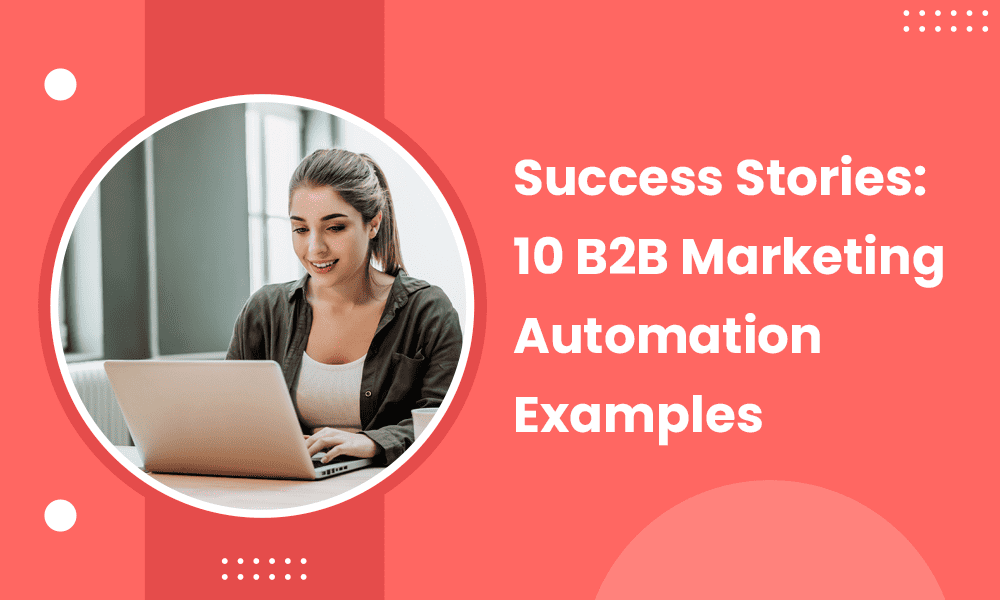Many B2B marketing automation examples show why companies in various industries are quickly adopting marketing automation today. According to Dun & Bradstreet, 78% of B2B businesses took on marketing automation to some extent. The same research shows that 46% of B2B companies extensively rely on marketing automation — that’s how effective it can be!
So, is B2B automation really required? Yes – in B2B marketing, every campaign is a long lead nurturing game with many tedious tasks. Since personalization is crucial for lead nurturing, incorporating B2B marketing automation tactics can be a game-changer in the following ways:
- Taking the burden of these repetitive tasks off your shoulders
- Leveraging real-time data to personalize interactions with your leads at every touch point
When implemented properly, B2B marketing automation can significantly increase leads and website visitors. It can boost sales, decrease costs, and generate more revenue for the company.
But what kinds of automation might aid your B2B marketing efforts? In this article, I’ll show you 10 awesome B2B marketing automation examples from top brands that we can all learn from.
Table of Contents
10 B2B Marketing Automation Examples From Top Brands
To help you understand what kind of tasks you can automate in B2B marketing, we have listed our favorite B2B marketing automation examples below that have changed the game for B2B digital marketing.
1. Boost your open rates with email marketing automation (Asana)
Email marketing automation is one of the most actionable B2B marketing automation examples. Emails offer a special platform to connect with your leads personally. They offer a way to build strong individual relationships.
With email marketing automation, you can deliver timely, targeted emails to your leads based on where they are in the customer journey. As a result, you can achieve higher open rates. Research shows automated transactional emails have a 4 to 8 times more open rate than regular emails.
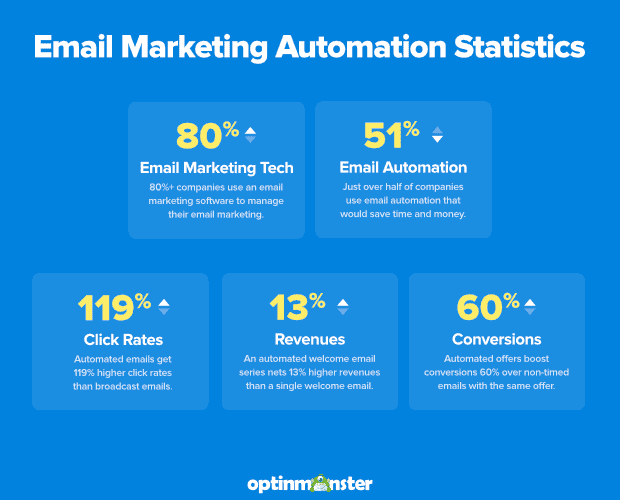
For example, if a lead converts to a customer, you may provide them access to an onboarding series that explains how to use your product to its full potential. Or, say, a potential lead has checked out your business and signed up but has yet to convert. You may send helpful, tailored reminders of how your solution can help them reach their goals and provide certain benefits in the market.
Take a look at this Asana’s welcome email campaign. It helps customers to get started by inviting them to create a new task.
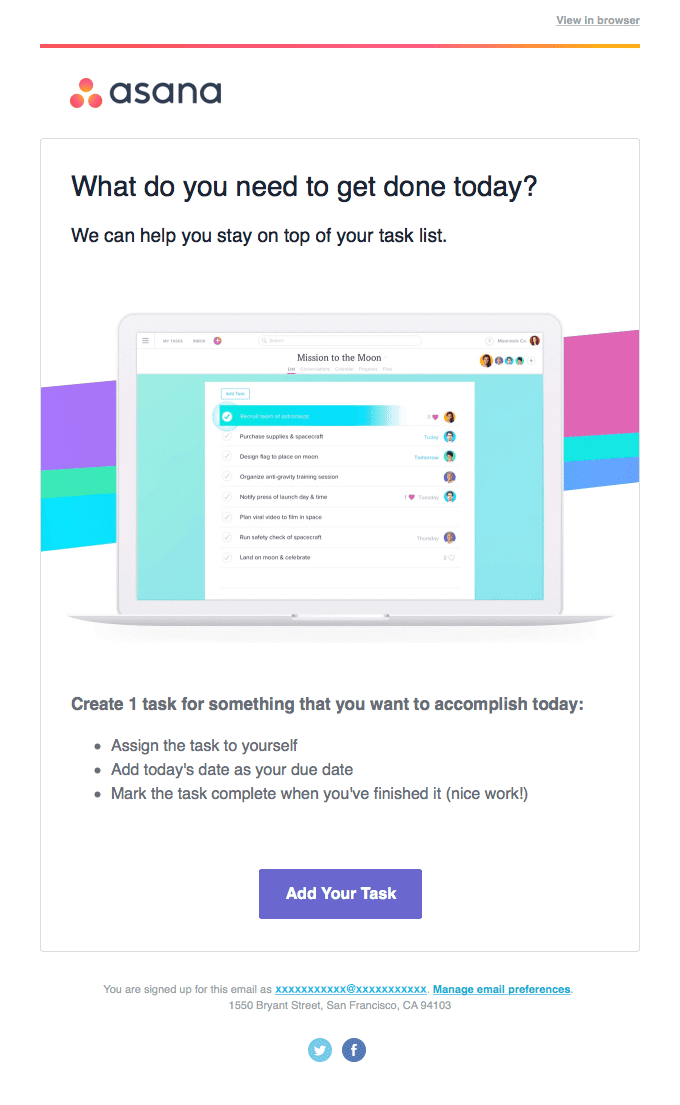
Steps to implement this B2B marketing example
- Set up an email marketing tool. To start, you’ll need easy-to-use email marketing automation software like EngageBay.
- Build and segment an email list. Have a list of subscribers to send automated emails to—it can be built organically with signup forms. Break up your list into smaller segments based on information like interests or behaviors.
- Set up an automation trigger. A trigger is an event or condition that will activate the automated campaign (this includes a newsletter signup, an abandoned cart, a subscriber’s birthday, a lack of engagement for X days, etc.).
- Create email campaigns. Design the automated email by creating images, texts, call-to-action buttons, discounts, brand logos, etc.
- Activate the automation. Choose the time to send the automated campaign and turn it on. Later, monitor how well it performs to find opportunities to improve.
Setting up email automation might sound complicated, but using the right tool makes it simple, even for beginners.
Pro Tip
For ease of implementation, choose a tool that provides customizable email templates. You can edit to personalize an email by adding your logos, images, footer, etc., and quickly set a trigger.
2. Increase productivity with CRM data management (Amazon)
Maintaining efficient sales operations and launching successful marketing campaigns depends on access to reliable and accurate data. However, it may be challenging to pick out the most qualified leads and effectively track sales progress with an outdated and congested customer relationship management (CRM) database.
In this case, by setting the right triggers, you can automate the sorting of CRM data to keep it clean and updated. By automating data management, you can let your marketing and sales team devote their time and energy to important tasks such as:
- Generating leads
- Closing deals
One of the best B2B marketing automation examples is from Amazon, which instantly captures customer data to customize its marketing strategy based on each customer’s online experience. For this reason, customers receive marketing emails based on their purchase history.
Steps to implement this B2B marketing example
- Review your data input sources to map how your CRM collects data.
- Clean your existing data by deleting inactive or duplicated leads.
- Create standardized templates, including phone numbers, addresses, and other criteria your data falls into.
- Set rules and policies for automating data collection as per standards.
- Check out and integrate third-party add-ons that automate data verification and confirm new entries.
Pro Tip
Assign ownership of customer data management to a driven team member. They can keep a tab on the quality of customer data, and that can help your marketing a lot.
Read also: Why Companies Need B2B Marketing Automation Today
3. Stay available 24/7 with chatbot automation (Slush)
Chatbots are the way of customer service, saving the customer support team a lot of time and effort. Among all B2B marketing automation examples, this is a widely used one. Research shows a quarter of all businesses will primarily rely on chatbots for customer service, providing live chat options by 2027.
Why?
The following infographic may help you understand.
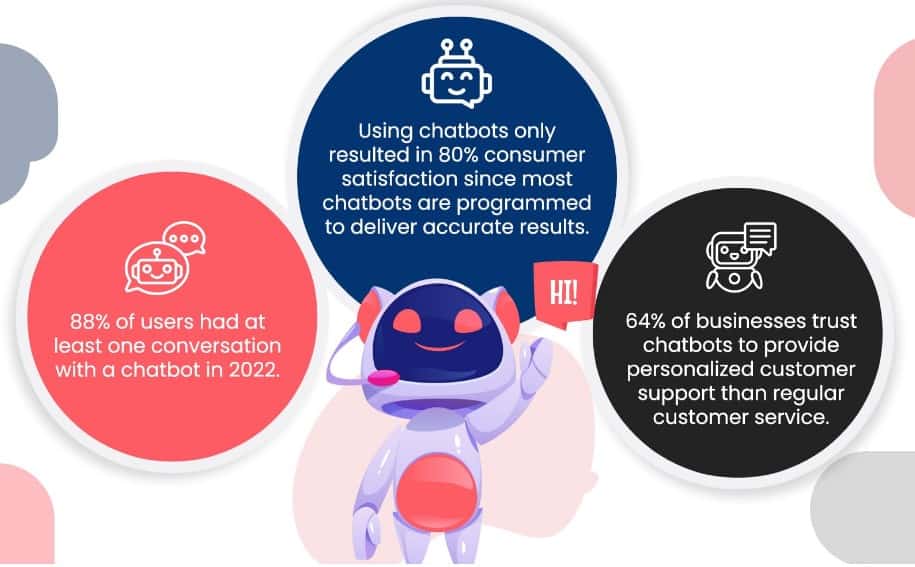
One of the most useful applications of chatbots is to provide instant answers to common inquiries and point visitors toward relevant content on your website. This method eliminates the need for leads to wait for responses from your customer support agents. It provides them with the knowledge they want immediately, whenever they need it.
The Jenny chatbot from Slush, the biggest startup event and VC gathering, is a great example. Slush uses the Jenny Chatbot’s conversational AI capability to address event-related inquiries immediately, such as:
- How do I get to the venue?
- What is the schedule of the event?
- What are nearby hotels to stay in?
The Jenny chatbot handled a massive 67% of customer service queries.

Steps to implement this B2B marketing example
- Choose a chatbot platform that fits your needs. There are various types of chatbots, such as rule-based, AI chatbots, conversational AI, etc.
- Build your chatbot using common customer questions, their responses, network alerts, and API.
- Before releasing the chatbot to the public, test it with staff and a small group of users. They may assist the chatbot in deciphering relevant terms. You may also discover bugs, missing intents, loopholes, etc.
- Once you feel confident about the chatbot’s performance, release it on your website, WhatsApp, telegram, or other platforms. Use metrics such as average handle time (AHT) and mean time to resolve (MTTR) to gauge its performance.
Pro Tip
You can also gauge the chatbot’s performance by tracking engagement metrics, such as CTR, bounce rate, and reuse rate.
4. Automate content personalization based on their buyer journey (Citrix)
When it comes to content, one size doesn’t fit all. Generic content can often do more harm than provide benefits. You can’t disseminate a piece of content and expect your entire target audience to find it relevant.
When you automate content personalization, you can present leads with content based on where they are in their buyer journey. It can guide them through your marketing funnel, from awareness to a purchase decision. Why? Because personalized content:
- Increases engagement
- Pursue your leads to take action (more conversion)
- It keeps them with you longer
For example, if you’ve got a lead from gated content, you know they’re interested in a specific topic or subject. You automate providing them with related content and help them move along their buyer journey.
To better serve its website visitors, Citrix used machine-learning algorithms to suggest more content based on user interest. So, when a user visits a Citrix webpage with a relevant whitepaper on the service, they get a popup window suggesting that they read the whitepaper.
Steps to implement this B2B marketing example
- Learn who visits your site, what they look at, and what they tell you about themselves via the forms they fill out.
- Based on the above information, segment the audience depending on interests, habits, and actions.
- Automate delivery of personalized content for each segment. Nurture them with additional relevant content until they can speak to the sales team.
Pro Tip
To implement this B2B marketing automation examples. You can also consider dynamic content on the website. It changes based on the user data (location, language, and other information).
Read also: How to Build the Perfect B2B Marketing Automation Strategy
5. Nurture your Leads with Timely Retargeting Automation (Iterable)
Lead nurturing is an essential process to build relationships with your prospects. According to Marketo, leads that go through the nurturing process experience a 23% reduction in their sales cycle duration compared to leads that have yet to receive nurturing.
Retargeting campaigns are the fastest approach to boosting profit margins. You can automate retargeting workflows on different channels, such as emails, push notifications, SMS, exit popups, and more. It lets you deliver a personalized message at the right time that encourages the customer to take action.
Take, for example, this email by iterable. This automation delivers an email to their prospects who have shown interest in their brand but couldn’t make it up. With timely retargeting, they get a chance to win back the sale.
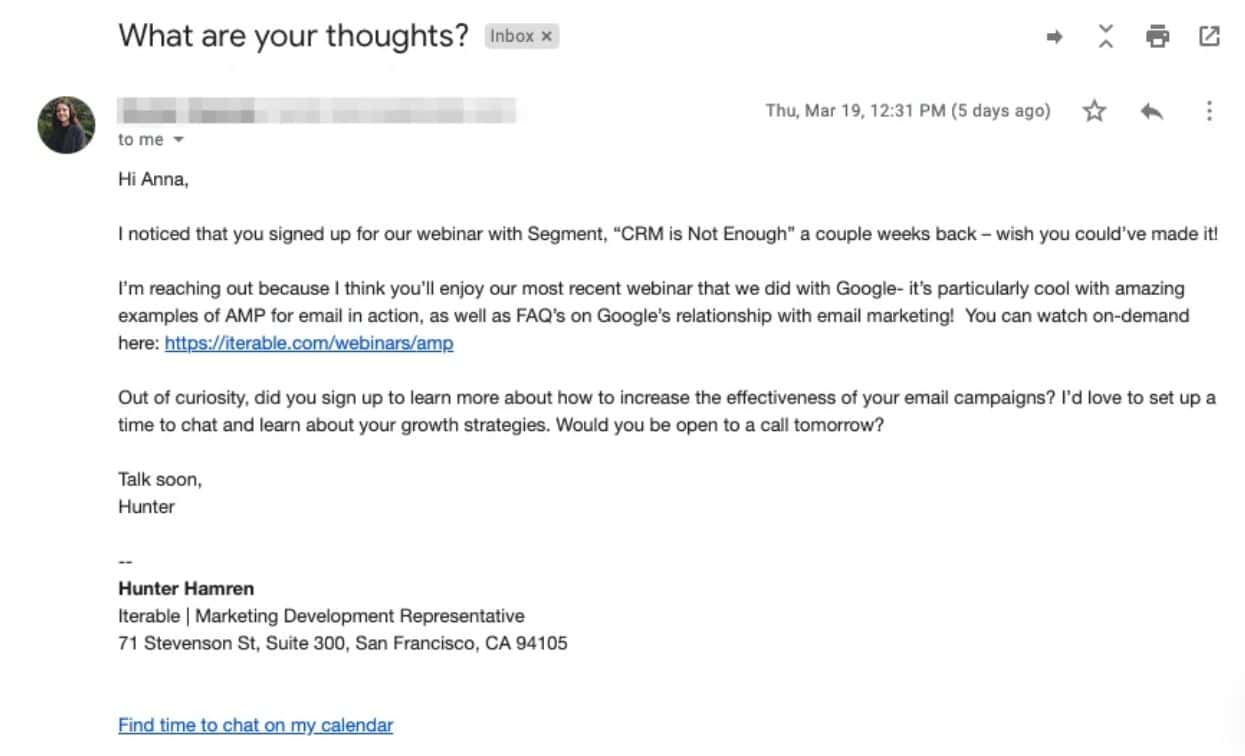
Steps to implement this B2B marketing example
- Decide channels for implementing marketing automation to deliver the retargeting message. It can be drip emails, social media, SMS, push notifications, etc.
- Set a desired retargeting trigger on your automation tools. You can automate sending a message via email automation first.
- Determine a specific time you’d like to wait before sending the second message. It can be another email or a message on a different channel. Set the time frame as the second trigger.
- Automate content delivery on the desired channel (SMS, email, social media messages, etc.) to send a personalized message. This message is delivered after a certain time passes from the time the lead receives an email.
If you want to find success through automated retargeting campaigns, create a retargeting blueprint.
Pro Tip
Combine retargeting efforts of more than one channel to reap maximum benefits. Got their phone number and email both? You can automate an immediate popup before the visitor exits your website, followed by an email an hour later, followed by an SMS a day later.
6. Minimize churn with NPS-triggered workflow automation (Trustmary)
Net Promoter Score or Net Promoter System (NPS) is an approach that measures customer loyalty. You may recognize the NPS survey from the question, “On a scale of 0 to 10, how likely are you to recommend our product or service?” Based on your rating, the NPS divides consumers into the following segments:
- Promoters: Consumers who love your brand and are likely to refer business with simply word of mouth.
- Detractors: Consumers who don’t like your brand. They’re likely to advise others against your business. They may choose competitors over you.
- Passives: These consumers don’t have an opinion about your brand. If they get more perks from competitors, they may give up your business.
Here’s a B2B marketing automation example of an NPS survey by Trustmary.

An NPS survey can be a great tool for customer satisfaction. You can reach out to people who provide negative feedback to reduce churn for your business.
To make this process more efficient, you can integrate NPS into your marketing automation funnels. NPS automation allows you to question customers at important points in their customer journey without manual effort.
This way, when you get a negative response, you can address it immediately without losing the customer over time.
Steps to implement this B2B marketing example
- Use your marketing automation software to set up a trigger. It can be after a purchase, renewal of a subscription, an interaction with the customer support team, etc.
- Create an NPS survey email using a survey email template.
- Set a follow-up workflow based on the NPS answer. For example, if people who respond 1 to 5 are detractors, automate a specific email to them. Send a different email to those who rate between 6 to 8 or 6 to 10.
Pro Tip
You can add a custom field for feedback for detractors to understand what makes them feel negatively towards your business. It can help personalize the content of the next email to satisfy their needs and save them from going.
Read also: Marketing Automation Use Cases & Examples [101]
7. Leverage PowerBI for Data-Driven Decisions (Amazon)
Data-driven marketing means having audience interactions relevant to the customer journey. Data-driven marketing includes several interacting elements:
- Marketing data
- The marketing staff
- The marketing approach
- The inbound strategy
- The content marketing
- Marketing campaigns
- The marketing tech stack
Manual data collection can be tedious. Let’s not forget it can also be prone to human error. Rote labor often slows data analytics attempts in the marketing efforts of many companies. Therefore, data analytics automation can streamline business analytics procedures for better insights.
Automated data analytics uses CRM connected to different databases to analyze data without human interaction. Rather than manually generating reports, a reporting pipeline generates insights with dashboards using visualization elements.
With data analytics automation, you can use the data insights to:
- Create more appealing content
- Deliver more personalized messages
- Adjust marketing strategies for better success
Amazon employs big data extensively for personalization and customer satisfaction across its diverse services and broad customer base. This strategy significantly boosts sales and enhances the effectiveness of features like ratings and reviews through machine learning. Also, these data help Amazon sellers to improve their business and revenue.
Steps to implement this B2B marketing example
- Use CRM tools to automate data collection from your different marketing channels and platforms.
- Select a platform that offers data analytics. Connect it to the CRM for data exchange.
- Set KPIs for data analysis, such as CTR, email open rate, etc. The platform will automatically process the data to present it on a visual dashboard.
- Keep track of your dashboard and understand trends to optimize your marketing efforts.
Pro Tip
Think of what you want to achieve with analytics before you automate data analysis. Do you want to understand market trends to create content? Or do you want insights into your campaign? Based on your goals, decide on the standard KPIs.
Read also: 11 Examples of Marketing Automation to Implement Today
8. Target specific customer profiles with LinkedIn ABM campaigns (Adobe)
Account-based marketing (ABM) is a marketing approach businesses use to focus on a select group of key clients rather than the market as a whole. This B2B marketing automation example tailors its marketing efforts to each account by considering their characteristics and preferences.
According to ITSMA, ABM has a greater ROI than traditional marketing strategies for 84% of organizations. Another SiriusDecisions research showed that 92% of B2B marketers considered ABM crucial to their marketing.
Did you know you could use LinkedIn Ads to launch hyper-targeted campaigns? Even better, you can automate the campaign by integrating contacts with CRM.
More than 13 million businesses now have their dedicated page on LinkedIn. To generate qualifying accounts to pursue at scale, you may use account targeting to compare your target accounts.
For example, the video below shows how Adobe optimized its marketing efforts. It reduced wasted resources with hyper-targeting using LinkedIn ABM.
Steps to implement this B2B marketing example
- Find your connections on LinkedIn and easily add them to your ABM campaigns by importing or integrating your current contact email lists. You may do this either automatically using third-party intent data partners or by linking your CRM with your LinkedIn ads account.
- Target highly promising leads with the help of the matched audiences tool.
- Follow up with and cultivate those leads using marketing automation technologies.
Pro Tip
Use website retargeting to track and interact with critical contacts at every stage of the purchasing process.
Read also: Marketing Automation 101 For The Beginner [With Examples]
9. Streamline sales assignments with online form automation (Hootsuite)
Inquiry and feedback forms need a system for collecting responses, storing them, and delegating them to the right people. It is possible to have employees review each submission, but that can take a lot of time. It’s better to automate this process to save your employees time.
You can have them focus on more important tasks, such as taking actions based on form responses. In this way, an automated online form tool can step toward providing excellent customer service.
For example, look at Hootsuite’s “request a demo” form. Customers may fill out this form to seek:
- A demo
- An upgrade
- Support
Hootsuite sends an automated confirmation email as soon as they receive a submission. Hootsuite may assign a relevant sales rep to connect with the lead based on the query.

Steps to implement this B2B marketing example
- Create inline forms using various styles and templates. Add relevant text and preview it. You can customize or add fields based on information you need from your leads.
- Add a success message or redirection link for the form that appears when a visitor fills it up.
- Automate an opt-in email or confirmation sent when a lead successfully fills in and submits the form.
- Save the form and generate an embed code. Use the code on your website to make it available to your audience.
Pro Tip
Choose from various pre-designed form styles and tailor them to your preferences.
10. Streamline appointments with reminder and rescheduling automation (AOA)
Set up automatic reminder emails or text messages sent to your clients before your appointment. It allows them to prepare for the meeting to reduce cancellations and no-shows. If they’re unavailable, they can reschedule with just a few clicks.
Use marketing automation platforms to deliver messages on autopilot before each meeting for each participant. Here’s an example of an automated appointment schedule reminder:
“Hello!
This email is a reminder for your demo session with __ on October 12, Thursday at 11 a.m. You don’t need to take any action to confirm the appointment. However, if you’d like to reschedule the meeting, set a new date with the link below.”
Alabama Ophthalmology Associates (AOA) uses an automated reminder strategy to reduce missed appointments drastically. They achieved the following:
- Confirmations from 79% of visitors
- Reduced no-shows rate
- Full-time equivalent (FTE) savings
Steps to implement this B2B marketing example
- Set a trigger for a new message on your preferred channel using your marketing automation tool.
- Select the message to send upon the trigger activation. Ensure to provide easy resources to reschedule.
- Set a time to send the message and turn on the automation.
Pro Tip
It would help to remind the invitee of the meeting’s purpose. If you send an email, you’ll have more space to state the importance of their attendance. Additionally, multiple reminders can ensure no meeting is missed/forgotten. You can schedule messages one a day in advance, one hour beforehand, and five minutes before the event.
Read also: 20 Marketing Automation Workflows for Amazing Results
Conclusion
Finding new leads and maintaining client interest throughout the buying process are two of the biggest concerns for B2B companies today. Fortunately, marketing automation can help businesses overcome these obstacles with data-driven workflow optimization options.
As you have noted from the B2B marketing automation examples above, you can streamline the process of guiding leads into your marketing and sales funnels with simple automation. These automation strategies allow B2B companies to grow their client base, streamline operations, and get deeper customer insights.
We hope our B2B marketing automation examples shed light on the breadth of opportunities automation presents for your business goals. If you want to try a marketing automation solution that has a CRM built-in, try EngageBay — one of the most affordable all-in-one software you can find.
FAQs
What is B2B marketing automation?
B2B marketing automation refers to the automation of repetitive marketing activities to generate and nurture leads using marketing automation tools.
How is B2B marketing automation different from B2C marketing automation?
While B2C marketing automation emphasizes a personalized customer journey at each point for every customer, B2B marketing automation enhances the education of the target audience. It aids lead generation through mass dissemination of content and then nurturing them through the sales funnel with personalization.
What are some B2B marketing automation examples?
You can automate several B2B marketing tasks with a robust marketing automation platform. However, some common B2B marketing automation examples include email automation, chatbot automation, content personalization automation, etc.
